I’d heard tell of Andy’s amazing homemade pizzas, and knew firsthand just how passionate he is about food, and pizza in particular. But tasting is believing and the other night I had the good fortune to sit in on Andy’s new pizza making class based out of his home in Be’er Sheva, Israel. Andy, a friend and fellow Anglo in Israel, has spent a lot of time reading and experimenting, all in the name of making the ultimate, Italian pizzeria-quality pizza at home. And he’s succeeded. Using no special equipment and a standard stove and oven, Andy has figured out (with the help of Jim Lahey’s no-knead dough recipe) how to make the best Neopolitan-style homemade pizza I’ve had. And he makes it look so easy!
Pizza, says Andy, is “all about balance. What makes pizza or any foods great – especially composite foods – is the balance if flavors and textures.” And that all begins with the dough; if you don’t want to eat the crust, says Andy, then the pizza isn’t that great. “For me one of the laws of pizza is good bread covered in good stuff that makes it better.”
So he starts with his slight adaptation of Jim Lahey’s no-knead pizza dough recipe, which calls for mixing the ingredients together then leaving them alone to rest, rise, and develop flavor for at least three days in the fridge. When ready to go, you separate the dough and gently roll it into balls, then let it rest and rise again. From there, he presses down in the center of the dough gently with his fingertips to create a bunch of indentations, then picks it up and rotates it to stretch the dough. You don’t want to roll out the dough or you’ll roll out the air bubbles, which are what create that characteristically bubbly crust.
Then, get this, he puts the stretched dough onto a really hot, oven-proof skillet (aluminum or cast iron are ideal; he recommends a surface thermometer to accurately gauge the heat) set over a gas burner. He applies the sauce (simply crushed, canned San Marzano tomatoes with a little salt) and some good quality shredded mozzarella. By the time he’s done that it’s been about a minute and the bottom has developed a nice crust.
Next it goes in the preheated broiler to finish up, and often he leaves the door ajar to keep the broiler working (if it reaches the temperature it will shut off). The pizza is in there for just a few minutes, and then out it comes and onto a cooling rack, picture perfect.
All Andy does to finish the pizza is top it with some chiffonade fresh basil and maybe some grated parmesan and a drizzle of extra virgin olive oil. There you have it! Homemade pizza that takes a little forethought but not a lot of active time on your part. Should you manage to have any leftover, Andy says the best way to reheat pizza is in a covered pan on the stove over low heat.
- 500 grams (17 ½ ounces or about 3 ¾ cups) all-purpose flour
- 2 grams (1/2 teaspoon) active dry yeast (can do 1 gram or ¼ teaspoon if you have time for a longer ferment)
- 16 grams (2 teaspoons) fine table salt (you need more if you use course or kosher salt)
- 350 grams (1 ½ cups) water
- 1 small can of crushed Italian plum tomatoes, OR a 2 cans of well-drained whole plum tomatoes that you mash up well.
- ½ teaspoon of salt
- ⅛ teaspoon of freshly ground black pepper
- optional - 1 finely minced/pressed garlic clove
- optional - chopped fresh oregano and/or basil
- optional - ½ teaspoon of sugar and teaspoon of red wine vinegar to "intensify" the sweetness and acidity
- 350 grams of mozzarella should be sufficient for 4 pizzas
- Fresh basil, chiffonade
- Freshly grated Parmesan or Pecorino Romano (optional)
- Extra virgin olive oil (optional)
- Mix your dry ingredients well so that the yeast and salt are well distributed
- Add the water a bit at a time, stirring each time to incorporate the water
- When all the water is added, mix until there is very little remaining dry flour. It should be a fairly sticky and "ragged" lump of dough. Cover it well - with either a tight-fitting lid and/or plastic wrap
- If you want to use it later that day, let it sit out for a minimum of 8 hours, and a maximum of 18 hours. Otherwise, let it sit out for 6-8 hours and then put it in the refrigerator for anywhere between 2 and 5 days. Take it out of the refrigerator at least 4 hours before you plan to use it so that it can come to room temperature.
- When ready to use, dump out the dough onto a well-floured surface and cut into 4 equal-size portions. Take each of these and knead for about 1 minute until smooth.
- Make smooth balls of dough using the inside-out pull and pinch on the bottom technique. Leave them on the counter, dusted with flour, for a minimum of 30 minutes, covered with a damp towel. 1-2 hours is best.
- To make the dough rounds, flatten the dough ball with your fingers. Use a little pulling and gravity to get the round about 50% larger. Stretch it the rest of the way by laying the dough on the backs of your hands, making fists, and stretching the outside of the dough round more and more, rotating it along the way.You want a fairly uniform thinness in the middle of the round, with a thicker ring going around the outside. (For a smoother (and still very good) final product without the irregular bubbles, you can also roll it out with a rolling pin. It really is fine this way (though perhaps less authentic and fun), and you are more likely to have a round pizza of uniform thickness that doesn't tear.)
- Just before cooking the pizza, mix together the sauce ingredients and leave by the stove.
- Put a large, oven-proof pan on your largest burner on high, and get it as hot as it can get - about 10 minutes. A drop of water should dance like crazy and evaporate in about 10 seconds.
- Turn on the broiler ("grill") of your oven and put the rack as high as it will go with your pan sitting on it.
- When the pan is hot, put your dough round right in it and cover it with sauce, shredded mozzarella (go easy with the cheese, you should see plenty of sauce through the cheese), and a little dribbling of olive oil.
- When you see that the dough has puffed up a bit (after about 1 minute), place the entire frying pan in your oven under the grill. Take it out when the top is as browned as you would like it to be.
- Add some fresh basil if you'd like, and/or some dry aged cheese like Parmesan or Romano.
- Allow the pizza to cool on a wire rack for 3-4 minutes. Don't just put it on a flat surface, or the crust will lose its crispness from the trapped steam.
- Cut with a pizza cutter or scissors, and enjoy!
If you are in Israel, Andy recommends Gad, Tenuva, or WiliFood mozzarella. He says you can try some of the Gad fresh mozzarella as well, but if you do, don't shred it - tear it or cut it into cubes.
Andy's Topping Rules of Thumb 1) Anything thick that contains a lot of liquid (zucchini, mushrooms, spinach) or are hard (broccoli or cauliflower) should be roasted/sauteed first over high heat (or cooked in the microwave to remove the moisture). 2) Otherwise, cut your toppings very thin. 3) Apply the toppings sparingly, you should still see cheese and sauce through the toppings. 4) Season your toppings with a little salt - if they are bland on their own, they will be bland on the pizza.
I’ve only relayed a tiny percentage of Andy’s pizza-making knowledge here – he also went into a huge lesson on pizza styles around the world, and I’m sure students can expect a lot more in the next three classes. If you are in Israel (in particular the Be’er Sheva area) and are interested in signing up for one of Andy’s future pizza-making classes, email him at andyshapirokatz@gmail.com. I highly recommend it!

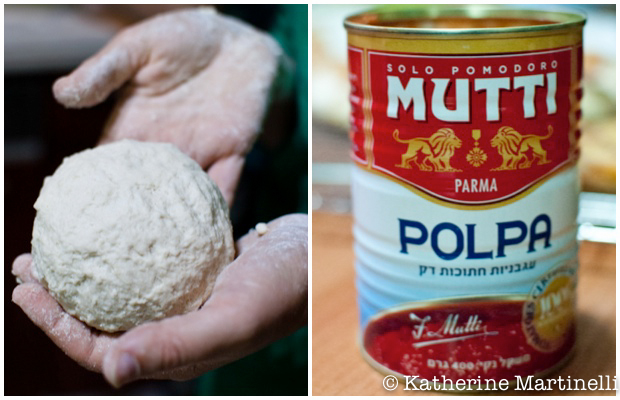
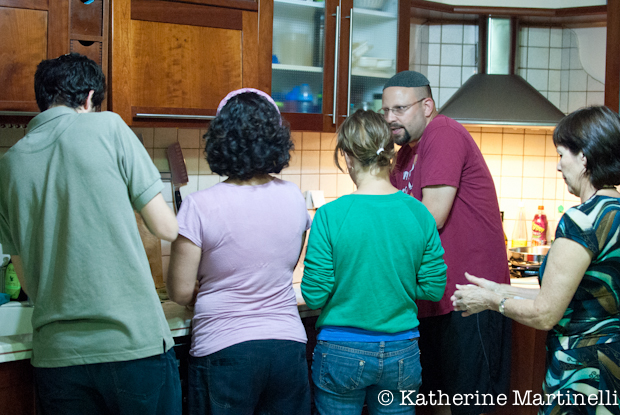
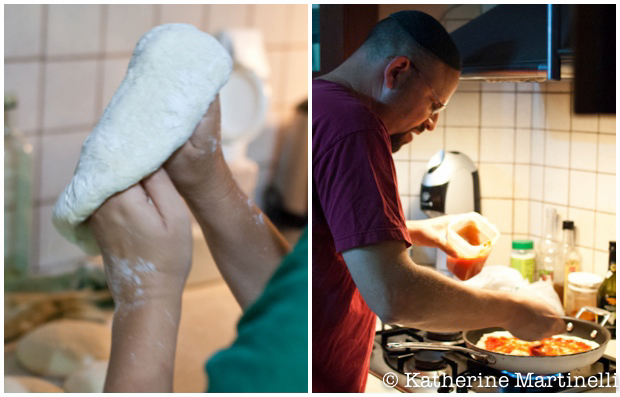
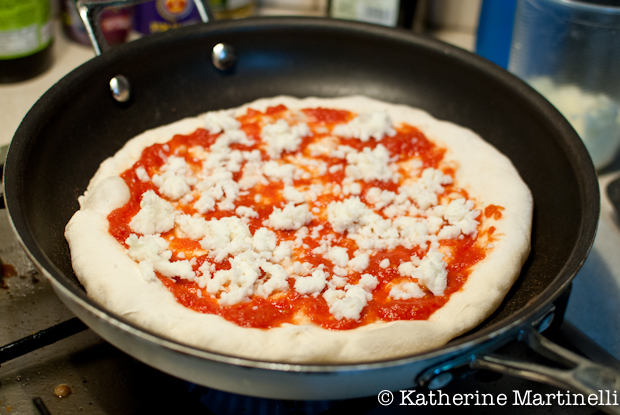
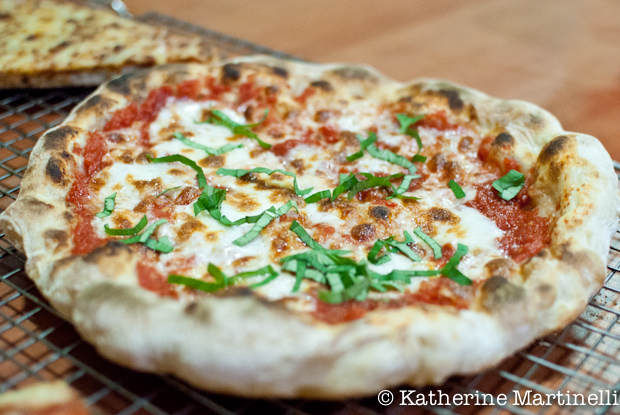
Genius! Pizza really is about the crust and I’d be willing to put the time in to try this one. Also, LOVING the cooking method! For as much as I make and we eat pizza I’ve never posted a recipe…hopefully a sauce one will suffice for the hop ;D Now I want proper pizza…
I love a simple pizza like this with no meat, my favorite. Thanks for hosting!!
Jim Lahey’s bread recipe is outstanding, so I’m sure his pizza dough recipe is world class too. It’s been ages since I’ve made a pizza – we love really close to several excellent places, so takeout usually beckons us. But one of these days I really need to make our own again. Good stuff – thanks.
What a yummy theme this week Katherine! I’ve actually never made pizza from scratch so I shared my super easy stuffed pizza melt using sandwich thins for the crust!
Have a wonderful weekend!
My best,
Nancy
I adore homemade pizza and yours does look spectacularly beautiful and delicious!
Wow,I must try this one day.Used to make quite much homemade pizza when my son was a kid.
I need to try this no-knead pizza dough! Although I live in pizza mecca, there’s something so satisfying about making your own pizza from scratch at home.
This looks fabulous and I wish I was in Beer Sheva to take his class. One day I will have to try making pizza. Organization is not my strength and so planning ahead isn’t my forte. But by the looks of this pizza, I might have to change that!
Great way to get the best crunchy crust. Wish I could stretch the dough like that!
There are so many little elements in this recipe that make it both easier and better –
1) The no-knead dough needs time for the yeast to essentially knead the dough chemically. This enables the dough to develop more flavor. The dough is also more extensible – meaning that it stretches out and stays there.
2) The skillet-broiler cooking method means that you don’t need to have a stone, you barely need to preheat your oven, and you don’t need to develop the skill of sliding a fully-topped pizza off a pizza peel into your oven. But it also gives you the more intense heat that causes great oven-spring (when the dough puffs up) and the “leopard-spotting” char on the bottom that is a hallmark of Neapolitan pizza.
3) The no-cook sauce is more authentic for a Neapolitan pizza than anything cooked or God-forbid, made from tomato paste. BUT, you really need to make sure you have good tomatoes. That is MUCH easier in the US, where you can find cans of imported San Marzano tomatoes, or similar California-grown tomatoes.
4) Given that the oven temperature is lower than a real wood-burning oven, genuine Italian pizza flour ISN’T really the best to use. But because this recipe aims at something LIKE a Neapolitan pizza, regular bread flour would make the dough too tough. So that means the best dough to use is regular all purpose flour – the flour you are most likely to have in your home (and the one that costs the least).
Note – the one major downside of this approach is that you are limited by the size of your frying pan. And depending on the stove you have you might not have a burner that puts out enough BTU’s to get your pan hot as hot as you want (between 525 and 550 degrees Fahrenheit).
This dough also works great for “grilled pizza.” Just stretch out your rounds and throw them on a very hot grill. When it begins to bubble, flip it, top it, close the grill lid, and let it cook another 1-2 minutes until the bottom is as done as you like. Just make sure that you top the pizza sparingly and that toppings are either cooked or sliced very thin. The top won’t cook all that much in a hot grill.
Wow thanks Andy! As I said, I barely scratched the surface of your knowledge in this post 🙂
This is a stunning pizza Katherine. I love everything about it. You know I am such a pizza lover.
Linked up a couple of recipes. Thanks so much for hosting.
This has my Italian seal of approval, although I use less yeast (which yield an easier to digest pizza) and I don’t flip the pizza over when I grill it.
Your Neopolitan-Style Pizza looks so yummy! I’ll try to make it for my family some time. Thanks for the recipe!
I only work with weights, and the conversions to volume above are all wrong. Here is what it should be:
500 grams (17 ½ ounces or about 3 ¾ cups) all-purpose flour
2 grams (1/2 teaspoon) active dry yeast (can do 1 gram or 1/4 teaspoon if you have time for a longer ferment)
16 grams (2 teaspoons) fine table salt (you need more if you use course or kosher salt)
350 grams (1 ½ cups) water
If you can correct the recipe above, that would be best. Sorry.
Fixed! Thanks Andy!
I want to try this so badly – it looks so tasty!!
I made this pizza as I’m currently on the search to find the best recipe and considering such basic ingredients, it tasted pretty good! But I do think 00 flour is the way forward. Feel free to check out my attempt at your recipe, and of others on my blog! http://www.myopizza.co.uk/dough-four-it/
Not entirely sure which pizza recipe you tested here, but it wasn’t the one on Katherine’s blog. Different flour, different amount of water, different amount of yeast, the addition of oil, kneading for awhile, etc. If you want to make amazing pizza with your own oven and kitchen equipment and the most easily found dough ingredients, you should really try the actual recipe. To give credit where it is due, it is the same dough recipe that Jim Lahey of the famed Sullivan Street Bakery in New York has shared with multiple publications.
Hi Andy! I’m quite embarrassed actually as I copied the wrong ingredients on my blog. Please see for an updated recipe as, aside from the flour I did follow your recipe. And the pizza (Despite being a complete amateur) was one of the best I’d made. I used semolina simply because I was told it’d be easier to stretch, as I definitely think I need lessons at it…
I see that the ingredients are now more or less the same, but its the combination of the ingredients and a couple of the techniques that is key here. First off, all-purpose flour works better for this recipe because it gives you a dough that is easier to work with, and a more tender crust that is closer in style to Neapolitan pizza. After that, they key is to just mix the ingredients until the flour is incorporated, about a minutes or two. And then you let it sit for hours on the counter-top. During this time it develops flavor, gluten, and it rises. After 8 or more hours (ideally closer to 18 in the wintertime when the kitchen is cooler), you portion it, form it into balls, and then let it rise another hour. That gives you dough balls that are easy to shape into rounds.
Love this recipe. May I suggest simplification for the dough recipe:
1 standard bag Israeli all purpose flour (1 kg)
1 tsp active dry yeast
4 tsp fine salt
3 cups water
Make up the dough, leave out overnight, refrigerate in the morning.
Hi I am so thrilled I found your web site, I really found
you by mistake, while I was researching on Aol for something else, Anyhow I am here now and would
just like to say cheers for a incredible post and a
all round interesting blog (I also love the theme/design), I don’t
have time to read it all at the minute but I
have book-marked it and also included your RSS feeds, so when I have time I will
be back to read more, Please do keep up the superb work.
You have got the most effective web sites
What’s up friends, its great article on the topic of educationand completely defined, keep it up
all the time.